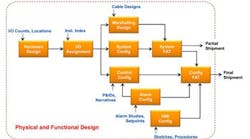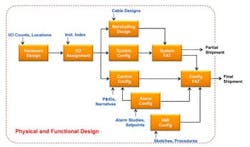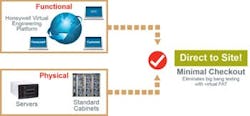Virtualization, coupled with cloud engineering, provides significant advantages for deploying process control systems at chemical plants. The technologies can prevent cost and time overruns — and thus improve overall results — on automation projects.
Today, when it comes to implementing process control systems, modular construction techniques are driving the need for early hardware shipments and reduced time to integrate components. In addition, global sourcing, geographically distributed engineering, and remote locations of construction sites make the project lifecycle increasingly dynamic by nature.
Figure 1. The nature of control systems design and delivery has remained largely the same for decades.
Unfortunately, execution issues afflict many projects. Indeed, according to the International Journal of Project Management, 70% of projects overrun their cost or schedule by 10–30%. This trend has gotten worse as larger and more complex projects involve a wider variety of engineering expertise and occur in areas of the world where standards vary and local expertise may be sparse.
Chemical firms must simplify what traditionally has been a long and expensive automation design process to get plants up and running quickly. Last-minute changes are inevitable and may mean a design must be altered, the build or configuration modified and, potentially, the testing of components repeated. However, major changes coming in the midst of control system deployment can result in months of delays and millions of dollars in costs and lost production.
During new construction, particularly on mega-projects, it’s crucial to minimize risk, increase flexibility, shorten schedules and, most importantly, keep automation systems off the critical path. This requires eliminating non-value-added processes — ones that essentially waste resources. Typical examples include rework and redundant tasks.
The growing demands placed on automation system suppliers to accommodate evolving project execution models have required reassessing traditional delivery models, which are sequential in nature. In fact, the processes employed in delivering control systems have changed little in the past 30 years, although the technology in these systems constantly has been evolving over that time (Figure 1).
Now, though, the workflow on projects can differ dramatically. New approaches to project execution can optimize processes and eliminate non-value-added activities that once were highly problematic. These techniques aim to drive effectiveness — not efficiency — because to efficiently do what is not required is not effective.
New System Design Approach
As business demands escalate, chemical companies are seeking ways to refocus and optimize their automation project strategies and, in so doing, achieve greater agility in hardware and software design. They also want to break down task dependencies on project teams and simplify control system implementation.
Figure 2. Separating physical and functional design enables earlier configuration and supports late data binding.
Rising hardware costs are prompting concerns among plant management about the number of computers in the facility as well as the total cost of ownership for its control system infrastructure. Deployments of manufacturing execution systems (MES), enterprise resource planning (ERP) software and human/machine interfaces (HMI) require dedicated physical server hardware, which frequently is under-utilized by a given application. In contrast, virtualized control system infrastructure can be run on multipurpose hardware that supports a greater variety of functionality with fewer but more versatile components.
Recent changes in project implementation strategies support the traditional workflow for physical hardware components and an independent workflow for functional software. This approach moves beyond lean execution by removing the traditional dependencies that restrict project workflows. It drastically improves the overall project schedule to keep automation systems off the critical path.
Separating the physical and functional aspects of a control system into independent hardware and software design activities enables performing both tasks in parallel. Breaking the dependence of software configuration from hardware delivery also allows undertaking configuration activities much sooner, prior to design completion. The functional and physical designs then are bound together at the conclusion of both workflows (Figure 2).
The Value of Virtualization
New “abstraction” methodologies provide the basis for transforming the way in which plant automation projects are executed. These techniques decouple physical design from functional design and support key project benefits such as:
• late binding of system configuration data;
• flexible hardware procurement;
• improved agility and flexibility; and
• enhanced design options.
Major automation suppliers such as Honeywell have found that abstraction methodologies can significantly improve large capital project implementation, resulting in up to 30% savings on automation infrastructure projects.
It’s now possible to achieve full abstraction of the control system infrastructure. Supervisory Control Level 2 nodes are abstracted via virtualization technology while Control Level 1 and input/output (I/O) are abstracted by flexible I/O solutions. This overall abstraction from the server to the I/O brings greater versatility to the traditional model of engineering an automation system.
Through virtualization technology, chemical plants can gain a supervisory platform that achieves tighter tolerances in less time and with lower risk than traditional physical designs and engineering techniques. Virtualization abstracts operating systems and applications from the underlying physical infrastructure by representing the hardware as virtual devices. Virtualization then allows multiple “virtual devices” to run on a single piece of server hardware called a host. This technique minimizes functional and physical design dependencies, with a huge reduction in hardware footprint and the adoption of standardized server cabinets.
Virtualization reduces the amount of detail required for physical design activities relating to the supervisory platform. For example, the number of host servers can be estimated without having to identify the exact server and operator station requirements. Each server can handle a wide band of both server and operator station needs, removing the 1:1 relationship that exists today.
In addition, virtualization can greatly improve schedule management by extending design freeze dates on automation projects. It enables engineering and configuring the entire control system before any hardware is required, allowing more time for physical design requirements to mature. After testing is completed, the virtual machines can be moved to the plant’s production server hardware late in the project cycle.
Figure 3. A virtual engineering platform largely can eliminate the need for onsite factory acceptance testing.
Lastly, virtual machines deliver significant savings in space, power, cooling and weight. Leveraging thin clients improves security while ensuring high availability and very fast mean time to recovery. Upgrading to a fixed-footprint blade server chassis — standardized at the supervisory layer — offers remote management capabilities that are preconfigured, shortening the time to deploy.
Engineers at a leading global chemical company can attest to the benefits achievable through virtualization. They were tasked with upgrading a control system at one of the firm’s North American sites. The upgrade was cost and schedule driven; the company lacked the funding to purchase the large number of servers required for the system configuration. This led the project team to opt for virtualization of the entire environment, so building of configurations could start immediately, rather than trying to fund the more costly approach of purchasing the physical hardware.
The use of virtualization technology helped accelerate the project by almost two years. Every month incorporated into the project translated into significant savings. Virtualization consolidated all of the resources required for purchasing and maintaining physical hardware into a single server cabinet. In addition, engineers didn’t have to wait for completion of the production design before creating configurations. Instead of pre-ordering equipment months in advance of implementation, they started adding more equipment on demand by employing virtual machines.
A Second Key Technology
Cloud engineering enables use of virtualization technologies to create a secure environment where an entire automation project can be staged without requiring the purchase of any physical hardware. The cloud environment offers engineers all the tools required to implement a simulated real-world control system and collaborate with colleagues.
For example, cloud engineering infrastructure provided by the automation supplier permits immediate spin up of the virtual engineering environment for a chemical unit expansion and controls migration. The globally available nature of this infrastructure allows the project immediately to draw upon a large pool of geographically dispersed engineers. When the engineering is completed, the project easily could transfer system designs from the virtual engineering environment to the plant’s engineering infrastructure. Performing the entire functional design in the cloud obviates purchasing any hardware for the purpose of executing the project.
In addition, this approach eliminates the need to wait for the instrumentation freeze before constructing and installing physical equipment, building and testing displays, and shipping them to the site. Rather, remote cabinets can be integrated in the construction of a process unit even if the precise point count and mix remains uncertain (Figure 3).
By utilizing the supplier’s virtual engineering environment for initial project engineering, the chemical plant can avoid the need for a hardware refresh at later stages of the project while compressing schedules and reducing risks. Hardware will be more current when it’s ready to be handed over.
Cloud engineering also affords better resource management. Engineers no longer must travel to the staging area to participate in a project. They can work concurrently and collaborate in the virtual engineering environment to design the system — with the final configurations loaded into the physical system infrastructure right before deployment.
At a chemical facility that’s refreshing its DCS and migrating to newer technology, a virtual factory acceptance test (FAT) can be conducted much like a regular FAT — because the virtualized equipment (controllers and servers) closely mimic the actual hardware. Project team members can shift between the virtual FAT and onsite activities without leaving the site. The operating company can expect to reduce travel and expense costs by 50–70% by taking this approach, and also minimize the requirements for final FAT.
Implementation Considerations
Succeeding with these new technologies on an automation project, whether for a new installation or an upgrade, strongly depends upon selecting a suitable technology partner. Always bear in mind that the design criteria go beyond standard IT considerations. Look for:
• standardized reference designs;
• global availability and support;
• determinism, performance, reliability and security at the core of the design; and
• a full range of applications that have been tested to run inside the virtualized environment.
Remember, too, the importance of protecting valuable intellectual property. This means utilizing a private cloud accessible only by the controls vendor and end user — not a public cloud or environment entrusted to a third-party data center provider. It’s best if your vendor 100% owns and centrally manages the virtual engineering platform and you already have a trusted relationship for optimization of resources, security, data protection, and virus and patching control.
Achieve Real Benefits
Virtualization and cloud engineering are revolutionizing the way automation projects are engineered. Used correctly with appropriate support from the automation provider, along with procedures and processes that maximize their benefit, these technologies can help chemical makers optimize their automation projects and reduce the lifecycle management costs of control systems.
PAUL HODGE is Sydney, Australia-based product marketing manager for virtualization for Honeywell Process Solutions. E-mail him at [email protected].





